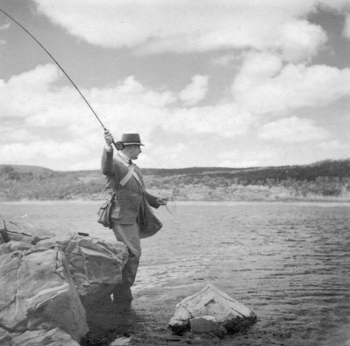J. Malcolm Gillies (1900-1977) of Victoria was a major creative and commercial influence in Australian fly fishing in the 1930s and early post-war years.
Though a Victorian, Gillies was strongly focused on Tasmania. He mainly fished the lakes of the central plateau, encouraged by Launceston car dealer Doug Hollis, for whom he worked from 1925 to 1928. At the onset of the Great Depression, he returned to Melbourne. After making some rods and flies for friends, he decided to make it his full-time work. He set up business from a workroom in his parents’ residence in the grounds of the University of Melbourne, where his Scottish father was a Professor at Ormond Theological Hall. In 1933 he married Jeanne Fawkner of Launceston.
Gillies’ rods were mainly powerful and fast-actioned, to cope with Tasmania’s high-country wind. His energy-efficient casting technique was based on the same ‘vee-grip’ hand position he used as a scratch golfer. This distinctive influence is still felt today among some top Australian tournament casters and fly fishers. Gillies himself won a number of distance and accuracy events at state and national level.
As well as his rods, Gillies designed fly reels and had them made in England. With the aid of three assistants he also made and sold many flies, both standard and his own invention. The most famous were his beetles, evolved when the Great Lake rainbow trout fishery was at its peak, and his Penstock Brown, an imitation of the mayfly species then dominant at Penstock Lagoon. His elegant early tackle catalogues are now highly valued collectors’ items.
J.M. Gillies became a proprietary company after World War II, and shifted emphasis from manufacturing to importing. Malcolm Gillies sold the firm on his retirement to Tasmania in the early 1960s, but as J.M. Gillies Agencies it remains a major player in the fishing tackle business.

